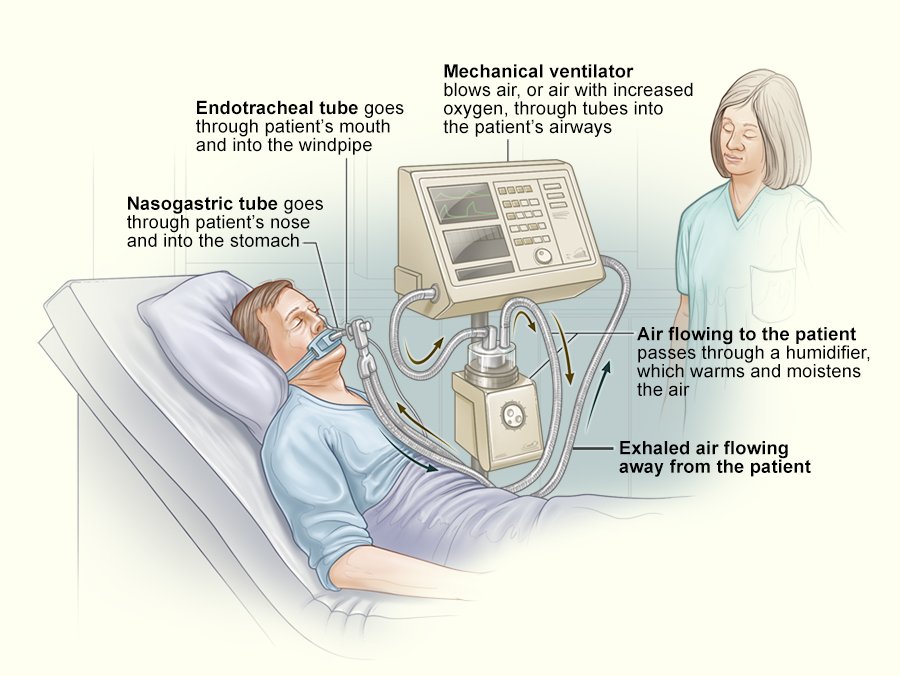The trigger (flow vs. pressure), the limit (what defines the amount of the breath), and the cycle are the three features of current ventilatory modes, which have traditionally been split into pressure and volume-controlled modes (what ends the breath). As with both VCV and PCV, the cycle is defined by how long it takes to come to an end. There is a flow cycle in the PSV, on the other hand. Let’s check out the types Of Ventilator Modes.
Remember that ever more complicated modes erode distinctions between pressure and volume-controlled approaches. As long as alerts and backup modes are configured correctly, the “disadvantages” of traditional methods (such as PCV’s danger of inadequate ventilation) may be almost removed. For historical reasons, volume control, pressure control, and other ways will be separated.
Controlling Volume in Various Ways –
Ventilation that can be controlled by others (ACV)
“Continual Mandatory Ventilation” (CMV) (CMV). All breaths are of the same volume, regardless of whether they help or control. There is an inverse relationship between volume and necessary expiratory time. ACV should be avoided by individuals who breathe quickly since it may cause hyperinflation and respiratory alkalosis in these patients. The diaphragm may still be quite active despite mechanical ventilation; therefore, it is essential to consider this.
Intermittent-Mandatory Ventilation Synchronized (SIMV)
In contrast to ACV, the patient can control a portion of their breaths, lowering the danger of hyperinflation or alkalosis. Mandatory breaths are timed to match with natural breathing patterns. SIMV’s drawbacks include higher respiratory effort and a potential reduction in cardiac output, leading to a longer time spent on a ventilator. Breathing may become more manageable if pressure assistance is added to the natural process of breathing. [Crit Care Med 10: 423, 1982] SIMV has been proven to reduce cardiac output in individuals with left ventricular dysfunction.
ACV and SIMV
Except in the following cases, personal choice reigns supreme: Switching to SIMV for those who breathe fast while on ACV is a good idea. 2. ACV should be used in patients with respiratory muscle weakness and left ventricular failure.
Modes of Pressure –
Ventilation that is Managed by Pressure (PCV)
Compared to ACV and SIMV, there is a lower risk of barotrauma. Breathing by the patient must be started by the nurse or doctor. Improved gas exchange is achieved by exponentially decreasing the inspiratory flow pattern’s peak pressures [Chest 122: 2096, 2002]. The biggest drawback is that there is no way to predict volume, which is particularly problematic when the mechanics of the lungs change. For individuals with neuromuscular illness but otherwise healthy lungs, PCV has typically been the treatment of choice.
Ventilation Designed to Reduce Pressure (PSV)
It can only be used to supplement a patient’s natural breathing since it allows them to manage the volume and frequency of their inhalation and exhalation. During weaning, 5–10 cm H20 of pressure support is often utilized to overcome the resistance of the ventilator tubing in another cycle or to boost spontaneous breathing. Face masks may be used to administer PSV.
Ventilation using pressure-controlled Inverse Ratio (PCIRV)
The bulk of the time is spent at the higher (inspiratory) pressure in this ventilation mode. Due to shortened expiratory duration and higher mean airway pressure, the danger of auto-PEEP and hemodynamic worsening outweighs the slight possibility for enhanced oxygenation in early studies.
Ventilation for Release of Airway Pressure (APRV)
Instead of being a PCV variant where the I:E ratio is reversed, Airway Pressure Release Ventilation (APRV) is a CPAP variation that releases pressure briefly on exhale, similar to PCIRV. The more significant airway pressures result from this specific form of breathing. High-pressure ventilation is the norm.
However, patients might spontaneously ventilate at either low or high pressures. APRV and PCIRV are equal in the absence of attempted breaths. Hemodynamic compromise is an issue in APRV, as it is in PCIRV. Additional sedation is often required as a result of APRV.
What are the two kinds Of Transmission in medical terminology?
Conclusion
Once it is established that a patient needs mechanical ventilation, several considerations must be taken, including the kind of mechanical ventilator to be used. Inspiratory assistance is referred to as the mode. Since there is no evidence that the method influences therapeutic outcomes, clinicians and institutions pick it up based on their preferences and familiarity.
I hope you like reading on Types Of Ventilator Modes Explained In Details

